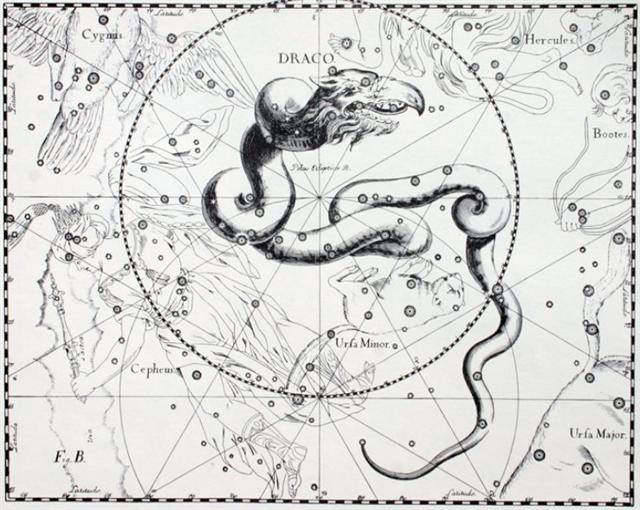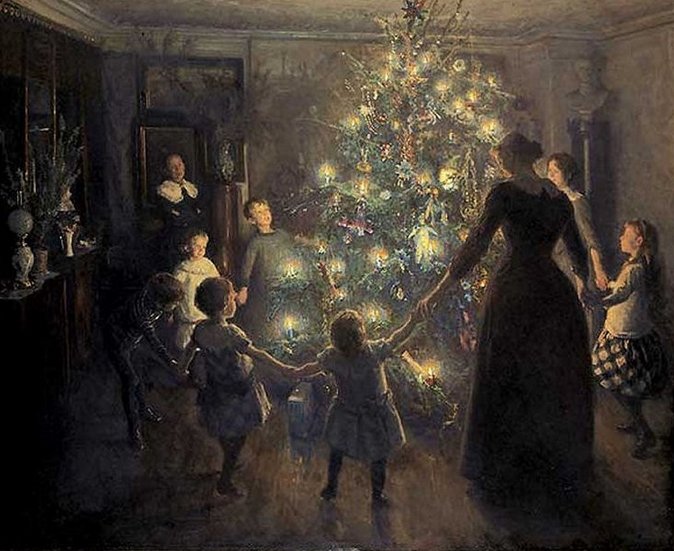270. Once again. The niu type of glyph, drawn as if in the resemblance of a windmill whirling around at the top - like a Southern Cross in the north - has been identified. ... The two great stars, which marks the summit and the foot of the Cross, having nearly the same right ascension, it follows that the constellation is almost perpendicular at the moment when it passes the meridian. This circumstance is known to the people of every nation situated beyond the Tropics or in the southern hemisphere. It has been observed at what hour of the night, in different seasons, the Cross is erect or inclined. It is a time piece, which advances very regularly nearly four minutes a day, and no other group of stars affords to the naked eye an observation of time so easily made. How often have we heard our guides exclaim in the savannahs of Venezuela and in the desert extending from Lima to Truxillo, 'Midnight is past, the Cross begins to bend' ...
... Night came, midnight came, and Tuu Maheke said to his brother, the last-born: 'You go and sleep. It is up to me to watch over the father.' (He said) the same to the second, the third, and the last. When all had left, when all the brothers were asleep, Tuu Maheke came and cut off the head of Hotu A Matua. Then he covered everything with soil. He hid (the head), took it, and went up. When he was inland, he put (the head) down at Te Avaava Maea. Another day dawned, and the men saw a dense swarm of flies pour forth and spread out like a whirlwind (ure tiatia moana) until it disappeared into the sky ...
... In other words, the ancient Druidic religion based on the oak-cult will be swept away by Christianity and the door - the god Llyr - will languish forgotten in the Castle of Arianrhod, the Corona Borealis. This helps us to understand the relationship at Rome of Janus and the White Goddess Cardea who is ... the Goddess of Hinges who came to Rome from Alba Longa. She was the hinge on which the year swung - the ancient Latin, not the Etruscan year - and her importance as such is recorded in the Latin adjective cardinalis - as we say in English 'of cardinal importance - which was also applied to the four main winds; for winds were considered as under the sole direction of the Great Goddess until Classical times. As Cardea she ruled over the Celestial Hinge at the back of the North Wind around which, as Varro explains in his De Re Rustica, the mill-stone of the Universe revolves. This conception appears most plainly in the Norse Edda, where the giantesses Fenja and Menja, who turn the monstrous mill-stone Grotte in the cold polar night, stand for the White Goddess in her complementary moods of creation and destruction. Elsewhere in Norse mythology the Goddess is nine-fold: the nine giantesses who were joint-mothers of the hero Rig, alias Heimdall, the inventor of the Norse social system, similarly turned the cosmic mill. Janus was perhaps not originally double-headed: he may have borrowed this peculiarity from the Goddess herself who at the Carmentalia, the Carmenta Festival in early January, was addressed by her celebrants as 'Postvorta' and 'Antevorta' - 'she who looks both back and forward'. However, a Janus with long hair and wings appear on an early stater of Mellos, a Cretan colony at Cilicia. He is identified with the solar hero Talus, and a bull's head appears on the same coin. In similar coins of the late fifth century B.C. he holds an eight-rayed disc in his hand and has a spiral of immortality sprouting from his double head ...
... Actually, we are up against a completely incomprehensible narrative of events which occurred during a sea voyage. The plant, according to Albright (AJSL 36, p. 281, n. 2) literally 'thorny grapevine' is supposed to grow in the apsu, and to be accessible by way of a 'water-pipe'. This pipe, rātu, however, is a conjecture right here: the word occurs only later when, after his bath in a well, and the following loss of the plant, Gilgamesh complains bitterly about his frustration, i.e., about having obtained a boon for the 'earth lion' instead of for himself. The 'earth lion', identified with the thievish serpent, is assumed in its turn to live 'in a well which communicated with the apsu' (Albright, 35, p. 194). It is then (GE 11.298) that the hero says: 'When I opened the water-pipe and (...) the gear, I found that which has been placed as a sign for me: I shall withdraw and leave the boat on the shore' (Speiser trans., ANET, pp. 96f.) ...
... Here at last I can complete my argument about Arianrhod's Castle and the 'whirling round without motion between three elements'. The sacred oak-king was killed at midsummer and translated to the Corona Borealis, presided over by the White Goddess, which was then just dipping over the Northern horizon. But from the song ascribed by Apollonius Rhodius to Orpheus, we know that the Queen of the Circling Universe, Eurynome, alias Cardea, was identical with Rhea of Crete; thus Rhea lived at the axle of the mill, whirling around without motion, as well as on the Galaxy. This suggests that in a later mythological tradition the sacred king went to serve her at the Mill, not in the Castle, for Samson after his blinding and enervation turned a mill in Delilah's prison-house. Another name for the Goddess of the Mill was Artemis Calliste, or Callisto ('Most Beautiful'), to whom the she-bear was sacred in Arcadia; and in Athens at the festival of Artemis Brauronia, a girl of ten years old and a girl of five, dressed in saffron-yellow robes in honour of the moon, played the part of sacred bears. The Great She-bear and Little She-bear are still the names of the two constellations that turn the mill around. In Greek the Great Bear Callisto was also called Helice, which means both 'that which turns' and 'willow-branch' - a reminder that the willow was sacred to the same Goddess ... Then there was another whirlwind which carried Ilmarinen, the Smith, instantaneously away from the top of the Tree and down to the other end of the axle of the mill, to the glommy baths of Sariola - i.e. he went from the winds which dried up to the water assembled in the belly of Canopus (Agasthya): ... Near where Osmo's field is bordered. // On the crown the moon is shining. // In the boughs the Bear is resting. ... Then the smith his steps arrested, // In amazement at the pine-tree, // With the Great Bear in the branches, // And the moon upon its summit. ... Then the aged Väinömöinen, // Lifted up his voice in singing: // 'Awake, oh Wind, oh Whirlwind // Rage with great rage, oh heavens, // Within thy boat, wind, place him // Within thy ship, oh east wind // With all thy swiftness sweep him // To Pohjola the gloomy. Then the smith, e'en Ilmarinen // Journeyed forth, and hurried onwards, // On the tempest forth he floated, // On the pathway of the breezes, // Over moon, and under sunray. // On the shoulders of the Great Bear // Till he reached the halls of Pohja, // Baths of Sariola the gloomy ...
Agasthya laid bare the enemies, he dried up, enabling the spirits to rise up again - like the flames arising from a fire. ↑ (†) ... The Pythagoreans make Phaeton fall into Eridanus, burning part of its water, and glowing still at the time when the Argonauts passed by. Ovid stated that since the fall the Nile hides its sources. Rigveda 9.73.3 says that the Great Varuna has hidden the ocean. The Mahabharata tells in its own style why the 'heavenly Ganga' had to be brought down. At the end of the Golden Age (Krita Yuga) a class of Asura who had fought against the 'gods' hid themselves in the ocean where the gods could not reach them, and planned to overthrow the government. So the gods implored Agastya (Canopus, alpha Carinae = Eridu) for help. The great Rishi did as he was bidden, drank up the water of the ocean, and thus laid bare the enemies, who were then slain by the gods. But now, there was no ocean anymore! Implored by the gods to fill the sea again, the Holy One replied: 'That water in sooth hath been digested by me. Some other expedient, therefore, must be thought of by you, if ye desire to make endeavour to fill the ocean ... Evidently the basic niu 'time piece' was modified for slightly different purposes:
|

.jpg)








